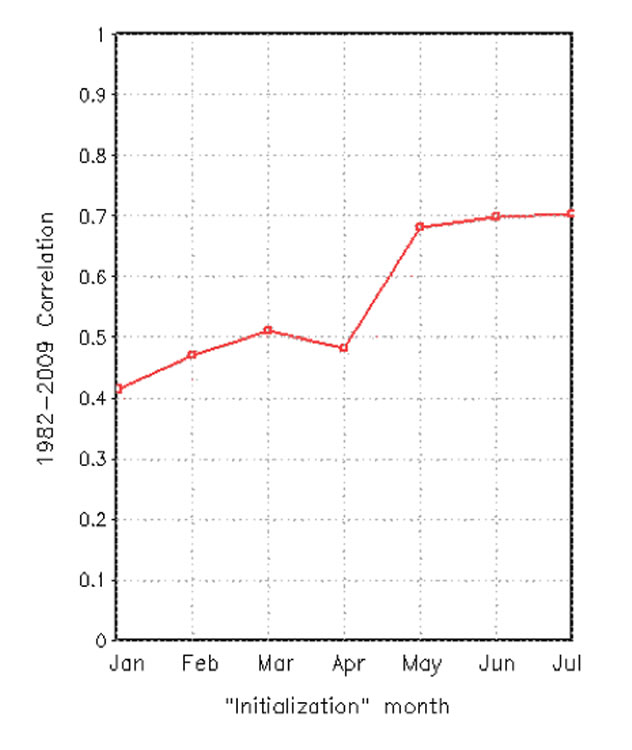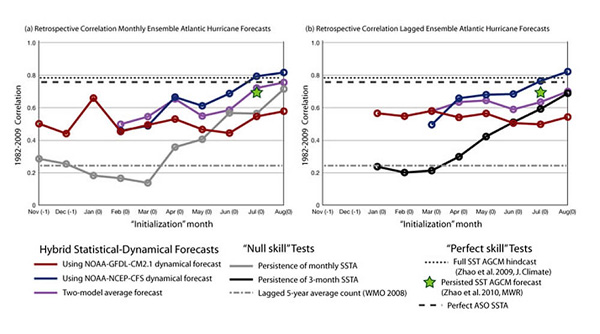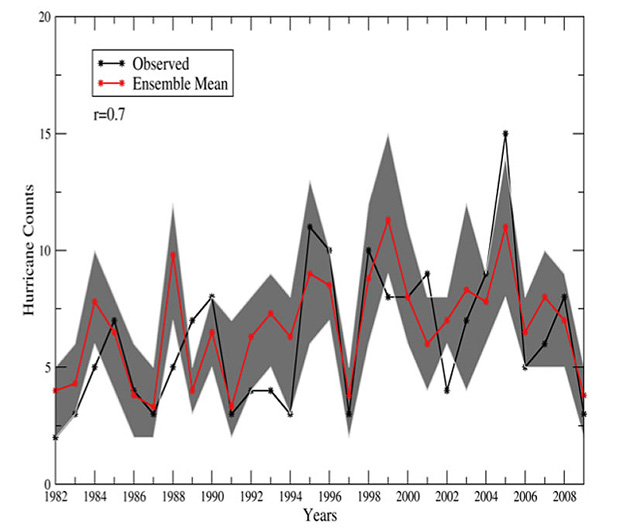Seasonal Forecasting of Tropical Cyclones
By Timothy LaRow, Hui Wang, and In-Sik Kang
How skillful are seasonal hurricane forecasts?
Motivation and Background
Tropical cyclones (TC), especially those of the strongest intensity, have large societal and economic impacts on the United States and many other countries throughout the world. In addition, major hurricanes (wind speeds ≥ 111 mph, CAT3-5) account for roughly 20% of all U.S. land falling tropical systems and they cause a disproportionate amount of the damage, about 80% [Pielke Jr. et al. 2008]. The basic premise of seasonal forecasting of tropical cyclones is related to the idea that tropical cyclones activity is closely tied to characteristics of the large-scale atmospheric circulation, sea surface temperatures (SSTs), vertical wind shear, and low-level vorticity. Early work on TC seasonal forecasting was done using statistical models [Gray 1984] in part because of insufficient computational resources to run high resolution atmospheric general circulation models (AGCMs). Operational dynamical seasonal TC forecasting began in Europe at the European Centre for Medium Range Weather Forecasts (ECMWF) in 2001 and in the U.S. at the International Research Institute (IRI) in 2003. Despite the low horizontal resolution of these atmospheric models they did exhibit modest skill [Vitart and Stockdale 2001; Camargo and Barnston 2009].
Research Summary
Figure 1 (adapted from Vecchi et al. 2011) shows the retrospective North Atlantic hurricane forecast skill as a function of initialization month compared to a variety of other estimates of predictability using the GFDL dynamical-statistical model. The system skill is evaluated using (a, b) correlation for both the simple monthly ensembles (a) and the lagged ensemble (b) schemes. The colored lines show the skill of the statistical-dynamical using GFDL-CM2.1 (red), NCEP-CFS (blue) and the two-model average (violet). The skill of the dynamical-statistical scheme is compared with two measures of “null skill”: the WMO suggested standard [WMO 2008] of a lagged five-year average for evaluation of hurricane forecast skill (gray dash-dotted) and the statistical hurricane frequency model applied to the persistence of SST anomalies (solid gray and black lines, for persistence of monthly and three-month SST anomalies). Two measures of “potential skill” are shown: the performance of the statistical hurricane model using observed August-October SST (black dashed line) and the performance of the HiRAM-C180 dynamical atmospheric model using observed monthly Rayner et al. [2003] SST fields from 1982-2008. For reference we show the Zhao et al. [2010] persisted June SST anomaly skill using the HiRAM-C180 dynamical atmospheric model (star symbol). The NCEP-CFS and two-model average schemes outperform the persistence forecasts for all months, and the GFDL-CM2.1 forecasts outperform persistence for all months prior to June. Figure 2 (adapted from LaRow 2011) shows interannual variability of North Atlantic hurricane activity from the FSU AGCM using SSTs predicted by the NOAA CFS coupled model initialized on 1 June of the respective year. The observed hurricane counts are shown by the black line while the model ensemble mean is shown by the red line with the ensemble spread shaded. The correlation is 0.7 using this two-tiered approach. Figure 3 (adapted from Wang et al. 2009) shows the forecast skill for Atlantic hurricanes using the CFS predicted August-October Main Development Region vertical wind shear as a predictor. This hybrid dynamical-statistical model was developed for predicting Atlantic seasonal hurricane activity at the NCEP Climate Prediction Center. The model is built upon the empirical relationship between the observed interannual variability of tropical storms/hurricanes and the variability of SST and vertical wind shear in hindcasts from the NCEP CFS.

Implications
Forecasts and retrospective forecasts of tropical cyclone activity on the seasonal and longer timescales from dynamical and statistical-dynamical (hybrid) models show skill comparable with that of many well known statistical models [eg., Vitart et al. 2007, Wang et al. 2009, Vecchi et al. 2011, LaRow 2011]. These studies strongly suggest that a large fraction of the climate information needed to make a skillful seasonal tropical cyclone forecasts lie in the evolution of the global SST pattern. Additionally, the retrospective skill in forecasting North Atlantic TC activity exceeds the skill expected from considering solely the influence of the El Niño/La Niña [Zhao et al. 2010, Vecchi et al. 2011].
Future Work
Avenues for future advancements in seasonal forecasting of TC activity involve the use of a multi-model forecast system in conjunction with the dynamical-statistical models to develop enhanced probabilistic estimates of TC activity.
Selected References
- Camargo, Suzana J., Anthony G. Barnston, 2009: Experimental Dynamical Seasonal Forecasts of Tropical Cyclone Activity at IRI. Wea. Forecasting, 24, 472–491.doi: 10.1175/2008WAF2007099.1.
- Gray, W.M. (1984): Atlantic seasonal hurricane frequency. Part ii: Forecasting its variability. Mon. Wea. Rev., 112, 1669–1683.
- LaRow, T.E. (2011): Atlantic Hurricane Activity and Sea Surface Temperature Trends. Submitted. Mon. Wea. Rev.
- Rayner, N.A., D.E. Parker, E.B. Horton, C.K. Folland, L.V. Alexander, D.P. Rowell, E.C. Kent, and A. Kaplan (2003): Global analyses of sea surface temperature, sea ice, and night marine air temperature since the late nineteenth century. J. Geophys. Res., 108(D14) 4407, doi:10.1029/2002JD002670.
- Vecchi, G.A., M. Zhao, H. Wang, G. Villarini, A. Rosati, A. Kumar, I.M. Held, R. Gudgel (2011): Statistical-Dynamical Predictions of Seasonal North Atlantic Hurricane Activity. Mon. Wea. Rev. (in press).
- Vitart, Frédéric, Timothy N. Stockdale (2001): Seasonal Forecasting of Tropical Storms Using Coupled GCM Integrations. Mon. Wea. Rev., 129, 2521–2537.
- Vitart, Frédéric, M Huddleston, D. Deque, D. Peake, T. Palmer, T. Stockdale, M. Davey, S. Ineson, and A. Weisheimer (2007): Dynamically-based seasonal forecasts of Atlantic tropical storms activity issued in June by EUROSIP. Geophys. Res. Lett., 34, L16815, doi:10.1029/2007GL030740.
- Wang, H., J. K. Schemm, A. Kumar, W. Wang, L. Long, M. Chelliah, G. D. Bell, and P. Peng (2009): A statistical forecast model for Atlantic seasonal hurricane activity based on the NCEP dynamical seasonal forecast. J. Climate, 22, 4481–4500.
- World Meteorological Organization (2008): “Report from Expert Meeting to Evaluate Skill of Tropical Cyclone Seasonal Forecasts.” World Meteorological Organization Technical Document No. 1455. Geneva, Switzerland. 27 pp.
- Zhao, M., I.M. Held, and G.A. Vecchi (2010): Retrospective forecasts of the hurricane season using a global atmospheric model assuming persistence of SST anomalies. Mon. Wea. Rev. 10.1175/2010MWR3366.1.
- Zhao, M., I.M. Held, S.-J. Lin, and G.A. Vecchi (2009): Simulations of global hurricane climatology, interannual variability, and response to global warming using a 50km resolution GCM. J. Climate, 22, 6653–6678.


